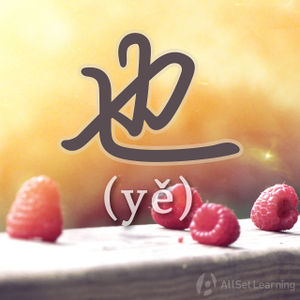The "also" adverb "ye"
-
Level
-
Similar to
-
Used for
-
Keywords
The English adverb "too" or "also" is expressed in Chinese as 也 (yě). In Chinese, it needs to always come before the verb (or adjective), though.
Contents
也 with Verb Phrases
Structure
Since it is an adverb, "也" is inserted after the subject, before the verb or auxiliary verb:
Subject + 也 + [Verb Phrase]
Please note that in English, we replace the word "too" with "either" in negative sentences. For example:
- A: I like cats.
B: I like cats too. - A: I don't like cats.
B: I don't like cats either.
In Chinese, regardless of whether the sentence is positive ("I like them too") or negative ("I don't like them either"), 也 is used the same way. Just make sure you put the 也 before the 不 (or other negative part that comes before the verb).
Examples
- 我 也 喜欢。I like it too. / I also like it.
- 我 也 有 一个 儿子 。 I also have a son.
- 他们 也 是 法国 人 。They are also French.
- 我 也 在 学 中文。I am also studying Chinese.
- 你 是 北京 人?我 也 是。Are you a Beijinger? I am too.
- 他 也 不 知道 这 是 什么 。He doesn't know what this is either.
- 我 知道 你 也 想 去 。I know that you also want to go.
- 我 也 喜欢 吃 水饺。I also like to eat boiled dumplings.
- 你 也 喜欢 喝 啤酒 吗?Do you like to drink beer, too?
- 你 也 会 来 我 家 吗?Can you also come to my home?
- 你 也 觉得 这 个 餐厅 不 好?Do you also think that this restaurant isn't good?
也 with Adjectives
Structure
也 can also be used with adjectives. Remember that for simple "noun + adjective" sentences you normally need to include an adverb like 很 (hěn) before the adjective. In that case, just put the 也 before the adverb.
Subject + 也 + Adverb + Adjective
Examples
- 你 也 很 高。You are also tall.
- 他 也 很 胖。He is also fat.
- 昨天 很 冷,今天 也 很 冷。Yesterday was very cold, and today is also very cold.
- 这 种 酒 也 很 好 喝。This kind of alcohol is also very good.
- 他 生气 了?我 也 很 生气!He got angry? I'm also very angry!
- 这 个 问题 也 很 麻烦。This problem is also very troublesome.
- 我 觉得 这 个 餐厅 也 很 好。I think that this restaurant is also good.
- 日本 菜 也 很 好吃。
- 我 爸爸 也 很 有钱。
- 湖南 菜 也 很 辣。
Expressing "me too" with 也
It can be tricky to know how to say "me too" when you first study 也, as you can't say "我也......" - this is not a complete sentence; you can't just leave 也 hanging there with nothing after it.
The correct sentence is "我也是," which literally means, "I am too," but can also stand in for "me too."
Structure
The correct structure uses the verb 是:
- 我 也 是。(The 是 fills in for whatever was just said.)I am too. / Me too.
- 我 也 。 (Always put something after 也! It never ends a sentence.)
Examples
The "me too" structure works with other subjects, as well.
- 他 也 是 。 He is too. / Him too.
- 我们 也 是 。 We are too. / Us too.
- 我 太太 也 是 。 My wife is too. / My wife too.
- 我们 公司 也 是 。 Our company is too. / Our company too.
- 中国 人 也 是 。 Chinese people are too. / Chinese people too.
- 巧克力 也 是 。 Chocolate is too. / Chocolate too.
- 冰 的 可乐 好喝,咖啡 也 是 。 Cold cola is good, and cold coffee is too.
- 他 不 吃 肉,我 也 是。 He doesn't eat meat, and neither do I.
- 你 喜欢 冬天,我 也 是。 You like the winter, and so do I.
- 你 喜欢 用 Android,我 也 是。 You like using Android, and so do I.
You'll notice that some of those translations use "so do I." The Chinese works exactly the same; they're just translated that way to produce more natural-sounding English.



